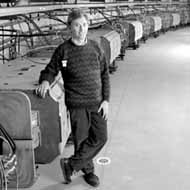 |
|
Fermilab creates a prestigious new fellowship... by Judy Jackson
Perhaps more than in any other field, advances in particle physics depend on advancing technologies of the tools of research. An important part of the science of high-energy physics is the never-ending development of accelerators to reach ever-higher energies. Last week, Fermilab recognized the importance of accelerator physics and technology to life on the energy frontier by announcing a new Fermilab scientific fellowship, named in honor of Fermilab Director Emeritus John Peoples. Like the Wilson and Lederman Fellowships named for Peoples' predecessors, it is designed to encourage and support outstanding young physicists. But unlike the earlier awards, the Peoples Fellowship is especially created to encourage world-leading research in accelerator physics and accelerator-related technologies. "The Peoples Fellowship is an indication of the renewed emphasis in the U.S. on accelerator and technology development for the future of high-energy physics," said Technical Division Head Peter Limon. "There are fascinating and challenging research problems central to the developing future of our field. Solving them will require high technology, scholarly thought and deep science." In announcing the Peoples Fellowship, Fermilab Associate Director Steve Holmes said the goal of the new fellowship is to put Fermilab in a position to attract first-rate accelerator scientists early in their careers. "Ultimately," Holmes said, "the prestige of this fellowship will depend on the quality of the people we select, and we are aiming for the very best. We are trying to target top people, the rising superstars of the field. We need the best people we can find to help us figure out what the future of our field will be." Fermilab physicist Jim Strait, project manager for the U.S. Large Hadron Collider accelerator effort, will chair the fellowship selection committee, which will accept applications through July 31, 2000. "We will try to make the first selection by late summer or early fall, and we hope to have the first Peoples fellow in place by the end of the year," Holmes said. "We expect that most Peoples fellows will work in either the Beams Division or the Technical Division. There are many R&D problems to solve in the areas of the Next Linear Collider, the muon storage ring, superconducting magnet research, as well as in more operational areas, such as Main Injector fixed-target capabilities or luminosity extensions in Run II." Unlike Wilson and Lederman fellowships that require several prior years of work in the field of particle physics, the Peoples fellowship committee will accept applications from physicists " right out of school," Holmes said. "It's an opportunity to get started early on a tenure-track position." Holmes said Fermilab also wants to create an opportunity for experimentalists in the field to make a change. "Look at John Peoples," Holmes said. "He did many things. He started out in life as an engineer and went on to get a Ph.D. in physics from Columbia. He became a successful experimental physicist and then turned his attention to building things, including Fermilab's Antiproton Source. In that same way, we believe that there are people who have concentrated on experimental physics who can make big contributions to accelerator technology." Starting this year at Fermilab, talented young experimentalists who yearn to take a crack at exploring the physics of accelerators will have the opportunity to do just that. All they have to do is make the Peoples choice. |
| last modified 4/14/2000 email Fermilab |
FRLsDFx9eyfrPXgV
 In high-energy physics, you're never done.
In high-energy physics, you're never done.